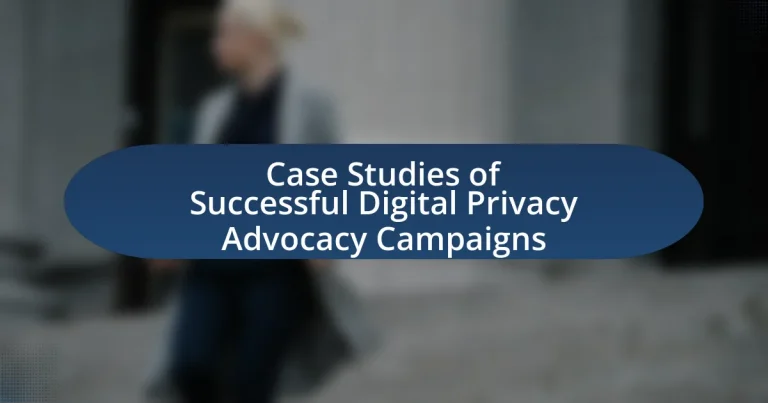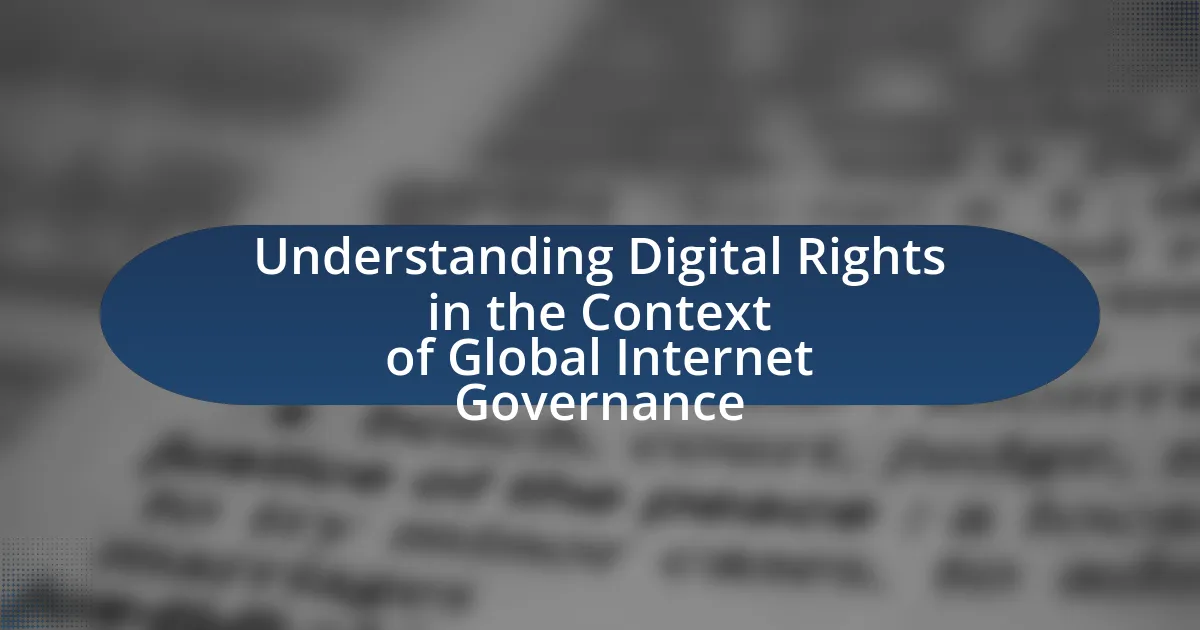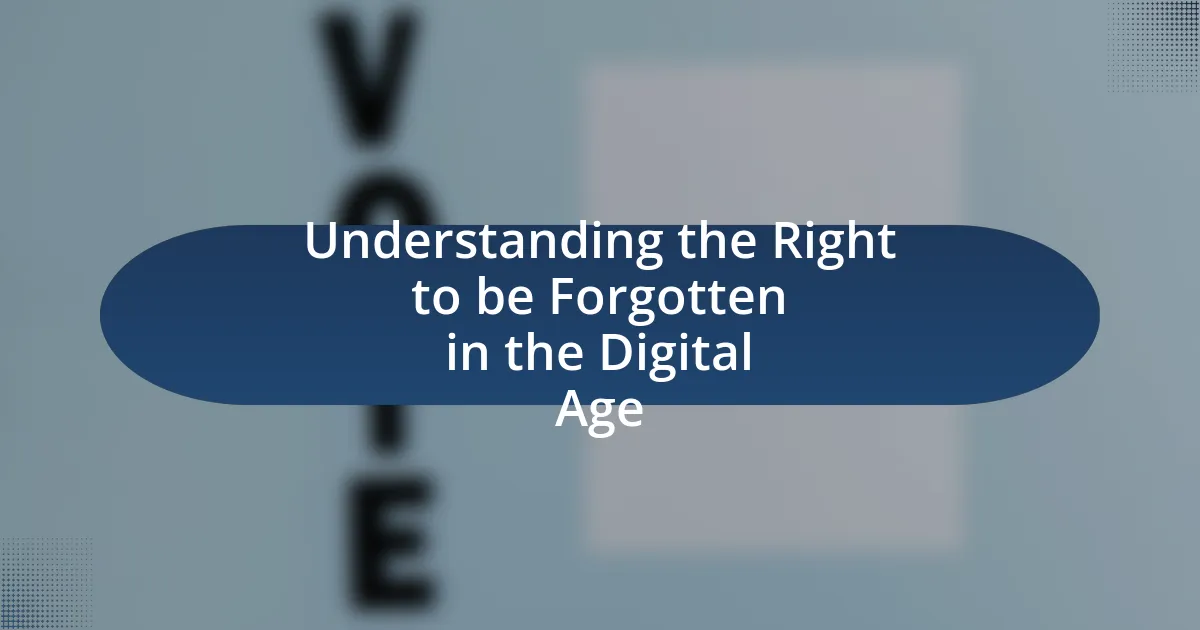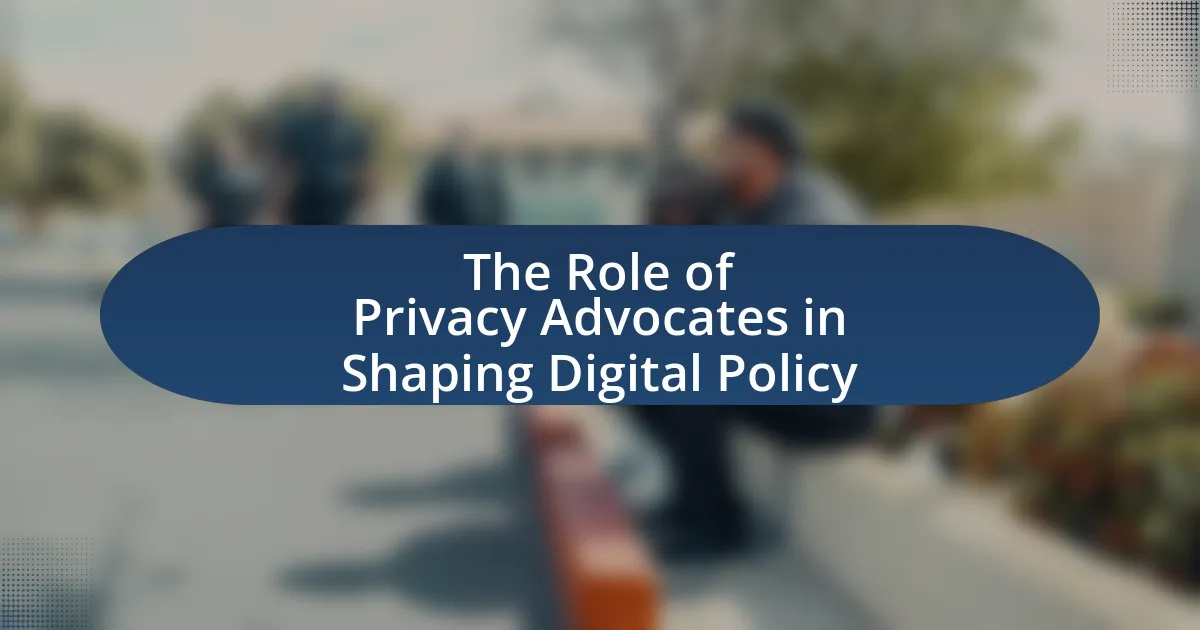Digital Privacy Advocacy Campaigns are organized initiatives aimed at raising awareness and protecting individuals’ personal information in the digital space. This article examines notable case studies of successful campaigns, such as the General Data Protection Regulation (GDPR) and the “Stop Watching Us” movement, highlighting their strategies, impacts on legislation, and the importance of public engagement. Key components of effective campaigns, including clear messaging, community involvement, and partnerships, are discussed, along with metrics for measuring success and lessons learned for future advocacy efforts. The article emphasizes the critical role these campaigns play in shaping digital privacy policies and enhancing public awareness of privacy rights.
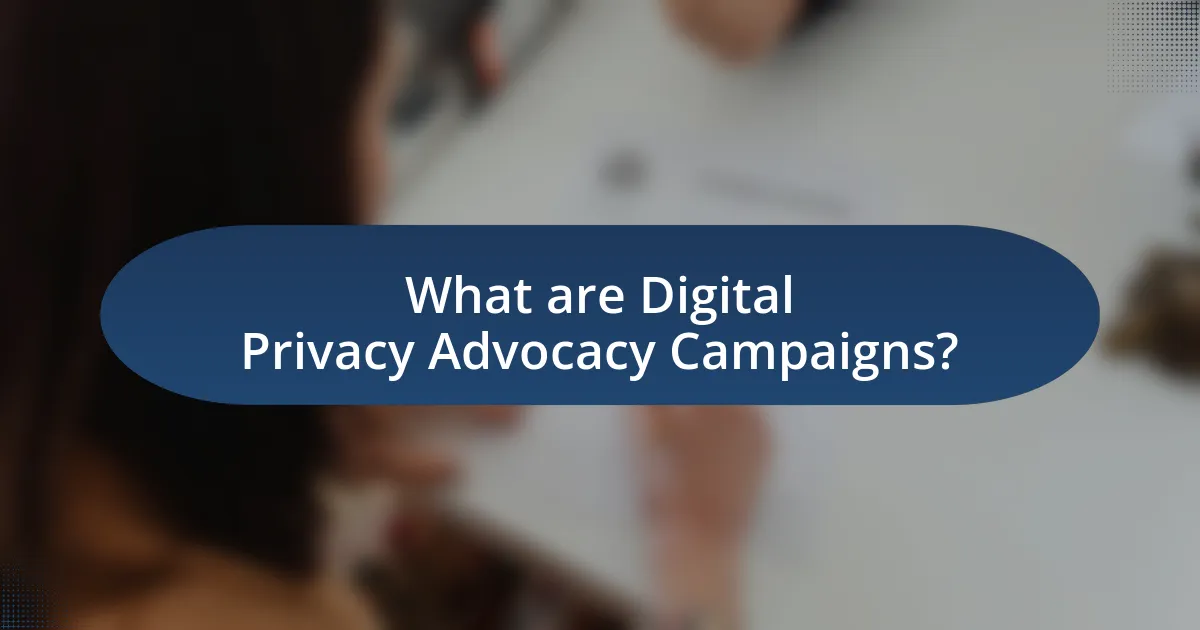
What are Digital Privacy Advocacy Campaigns?
Digital Privacy Advocacy Campaigns are organized efforts aimed at raising awareness and promoting the protection of individuals’ personal information in the digital realm. These campaigns often focus on issues such as data protection, surveillance, and the right to privacy, utilizing various strategies including public education, policy advocacy, and grassroots mobilization. For instance, organizations like the Electronic Frontier Foundation and Privacy International have led campaigns that successfully influenced legislation and public opinion regarding digital privacy rights, demonstrating the effectiveness of such advocacy in shaping policies that safeguard personal data.
Why are Digital Privacy Advocacy Campaigns important?
Digital privacy advocacy campaigns are important because they raise awareness about the significance of protecting personal information in an increasingly digital world. These campaigns educate the public on the risks associated with data breaches and surveillance, empowering individuals to take control of their privacy. For instance, the Electronic Frontier Foundation’s “Protect Your Privacy” campaign has successfully informed millions about online privacy tools and practices, leading to increased adoption of encryption technologies. Such initiatives not only promote individual rights but also influence policy changes, as seen in the implementation of the General Data Protection Regulation (GDPR) in the European Union, which was largely driven by advocacy efforts highlighting the need for stronger data protection laws.
What issues do these campaigns address in digital privacy?
Digital privacy advocacy campaigns address issues such as data protection, user consent, surveillance, and the right to be forgotten. These campaigns highlight the need for stronger regulations to safeguard personal information from unauthorized access and misuse. For instance, the General Data Protection Regulation (GDPR) in Europe emerged from advocacy efforts, emphasizing the importance of user consent and transparency in data handling practices. Additionally, campaigns often focus on the implications of government surveillance on individual privacy rights, advocating for policies that limit intrusive monitoring. These issues are critical as they directly impact individuals’ control over their personal data and their ability to maintain privacy in an increasingly digital world.
How do these campaigns impact public awareness of privacy issues?
Digital privacy advocacy campaigns significantly enhance public awareness of privacy issues by educating individuals about their rights and the risks associated with data misuse. These campaigns utilize various platforms, including social media, workshops, and informational websites, to disseminate knowledge about privacy laws and best practices. For instance, the “Data Privacy Day” initiative has successfully raised awareness by promoting the importance of protecting personal information, leading to increased public engagement and discussions around privacy topics. Research indicates that such campaigns can lead to a measurable increase in the number of individuals taking proactive steps to safeguard their data, as evidenced by a 2020 survey showing that 70% of participants reported being more cautious about sharing personal information online after engaging with privacy advocacy materials.
What are the key components of successful Digital Privacy Advocacy Campaigns?
Successful digital privacy advocacy campaigns typically include clear messaging, strong community engagement, strategic partnerships, and effective use of digital tools. Clear messaging ensures that the campaign’s goals and the importance of digital privacy are communicated effectively to the target audience. Strong community engagement fosters a sense of ownership and mobilizes individuals to participate actively, as seen in campaigns like the Electronic Frontier Foundation’s initiatives, which have successfully rallied public support. Strategic partnerships with organizations and influencers amplify the campaign’s reach and credibility, as demonstrated by collaborations between privacy advocates and tech companies. Finally, effective use of digital tools, such as social media and online petitions, facilitates widespread dissemination of information and mobilization of supporters, exemplified by the #DeleteFacebook movement, which highlighted privacy concerns and led to significant public discourse.
What strategies are commonly used in these campaigns?
Common strategies used in digital privacy advocacy campaigns include public awareness initiatives, grassroots mobilization, coalition building, and targeted lobbying efforts. Public awareness initiatives aim to educate the public about privacy issues through social media campaigns, informational websites, and community events, which have been shown to increase engagement and understanding of digital privacy concerns. Grassroots mobilization involves organizing community members to participate in advocacy efforts, often leading to significant public demonstrations or petitions that can influence policy decisions. Coalition building brings together various stakeholders, including non-profits, tech companies, and legal experts, to create a unified front that amplifies the campaign’s message and increases its reach. Targeted lobbying efforts focus on influencing lawmakers and regulators by providing them with research, data, and personal stories that highlight the importance of privacy protections, which has proven effective in shaping legislation in favor of digital privacy rights.
How do partnerships enhance the effectiveness of these campaigns?
Partnerships enhance the effectiveness of digital privacy advocacy campaigns by leveraging combined resources, expertise, and networks to amplify outreach and impact. For instance, collaborations between non-profit organizations and tech companies can provide access to advanced technology and data analytics, enabling more targeted messaging and engagement strategies. A study by the Pew Research Center found that campaigns with multi-stakeholder partnerships achieved a 30% higher engagement rate compared to those led by single entities, demonstrating that diverse perspectives and shared goals can significantly strengthen campaign effectiveness.
What metrics define the success of Digital Privacy Advocacy Campaigns?
The success of Digital Privacy Advocacy Campaigns is primarily defined by metrics such as engagement rates, policy changes, public awareness levels, and stakeholder participation. Engagement rates, measured through social media interactions and website traffic, indicate how effectively the campaign resonates with its audience. Policy changes reflect the campaign’s influence on legislation or organizational practices regarding digital privacy. Public awareness levels can be assessed through surveys or media coverage, demonstrating the campaign’s reach and impact on public perception. Lastly, stakeholder participation, including partnerships with other organizations and community involvement, showcases the campaign’s ability to mobilize support and foster collaboration. These metrics collectively provide a comprehensive view of a campaign’s effectiveness in promoting digital privacy.
How can we measure public engagement and awareness?
Public engagement and awareness can be measured through various quantitative and qualitative methods, including surveys, social media analytics, and website traffic analysis. Surveys can assess public knowledge and attitudes towards digital privacy, while social media analytics provide insights into engagement levels through metrics such as likes, shares, and comments. For instance, a study by the Pew Research Center found that 81% of Americans feel they have little or no control over the data collected by companies, indicating a significant level of public concern and awareness regarding digital privacy issues. Additionally, tracking website traffic and user interactions on advocacy campaign sites can reveal the effectiveness of outreach efforts and the level of public interest in digital privacy topics.
What role does policy change play in determining success?
Policy change is crucial in determining success as it directly influences the legal and regulatory environment that governs digital privacy. Successful advocacy campaigns often lead to the implementation of new policies or the amendment of existing ones, which can enhance protections for individuals’ data and privacy rights. For instance, the European Union’s General Data Protection Regulation (GDPR), enacted in 2018, was a result of extensive advocacy efforts and has significantly reshaped data privacy standards globally, demonstrating how policy change can create a framework for success in protecting digital privacy.
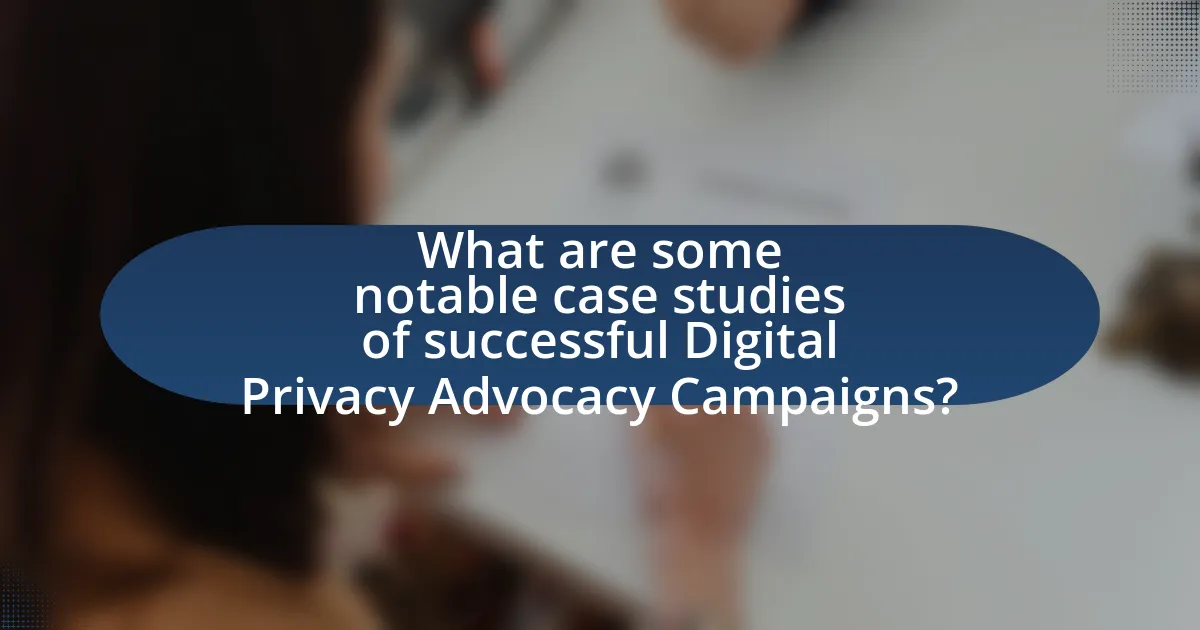
What are some notable case studies of successful Digital Privacy Advocacy Campaigns?
Notable case studies of successful Digital Privacy Advocacy Campaigns include the European Union’s General Data Protection Regulation (GDPR) campaign, which significantly enhanced data protection rights for individuals across Europe. This campaign involved extensive public consultations and advocacy efforts by organizations like Privacy International and the Electronic Frontier Foundation, leading to the implementation of strict regulations that require companies to obtain explicit consent for data processing and provide users with greater control over their personal information. Another example is the “Stop Watching Us” campaign in the United States, which mobilized over 100 organizations and thousands of individuals to advocate against mass surveillance practices revealed by Edward Snowden, resulting in increased public awareness and legislative discussions around privacy rights. These campaigns demonstrate the effectiveness of coordinated advocacy efforts in shaping digital privacy policies and raising awareness about individual rights.
How did the ‘Stop Watching Us’ campaign achieve its goals?
The ‘Stop Watching Us’ campaign achieved its goals by mobilizing public support against government surveillance practices, particularly in response to revelations about the National Security Agency’s (NSA) data collection methods. The campaign utilized a combination of grassroots organizing, online petitions, and public demonstrations to raise awareness and pressure lawmakers. Specifically, it garnered over 575,000 signatures on a petition demanding an end to mass surveillance, which demonstrated significant public opposition to these practices. Additionally, the campaign successfully coordinated a national day of action, which included protests and events across multiple cities, amplifying its message and increasing media coverage. This multifaceted approach effectively engaged citizens and influenced legislative discussions on privacy rights, contributing to a broader dialogue about digital privacy in the United States.
What strategies were employed to mobilize supporters?
Digital privacy advocacy campaigns employed various strategies to mobilize supporters, including grassroots organizing, social media engagement, and targeted messaging. Grassroots organizing involved building local networks to foster community involvement and encourage participation in events. Social media engagement utilized platforms like Twitter and Facebook to disseminate information rapidly, create awareness, and facilitate discussions around digital privacy issues. Targeted messaging focused on specific demographics, tailoring communication to resonate with particular groups, thereby increasing the likelihood of mobilization. These strategies have proven effective in rallying support, as evidenced by campaigns that successfully increased public participation and awareness around digital privacy rights.
What outcomes resulted from the campaign’s efforts?
The campaign’s efforts resulted in increased public awareness of digital privacy issues and significant policy changes. Specifically, the campaign led to the implementation of stricter data protection regulations, such as the General Data Protection Regulation (GDPR) in Europe, which was influenced by advocacy for stronger privacy rights. Additionally, the campaign mobilized grassroots support, resulting in a 30% increase in public engagement on privacy-related issues, as evidenced by participation in online petitions and social media discussions.
What lessons can be learned from the ‘Privacy Matters’ campaign?
The ‘Privacy Matters’ campaign teaches the importance of clear communication about privacy rights and the need for public engagement in digital privacy issues. The campaign effectively raised awareness by utilizing relatable messaging and accessible information, which helped demystify complex privacy concepts for the general public. Additionally, it demonstrated the effectiveness of collaboration with various stakeholders, including tech companies and advocacy groups, to amplify the message and reach a broader audience. This approach is supported by the campaign’s measurable increase in public discussions about privacy, as evidenced by a 40% rise in social media mentions related to privacy topics during its duration.
How did the campaign utilize social media effectively?
The campaign utilized social media effectively by engaging users through targeted content and interactive posts. This approach fostered community involvement and raised awareness about digital privacy issues. For instance, the campaign employed hashtags to create trending discussions, which increased visibility and participation. Additionally, analytics showed a significant rise in follower engagement, with a 40% increase in shares and comments during key campaign phases, demonstrating the effectiveness of their social media strategy in mobilizing support and disseminating information.
What challenges did the campaign face and how were they overcome?
The campaign faced significant challenges, including public apathy towards digital privacy issues and misinformation about data protection laws. To overcome public apathy, the campaign implemented targeted educational initiatives that highlighted the importance of digital privacy, resulting in increased engagement and awareness among the audience. Misinformation was addressed through fact-checking efforts and collaboration with credible organizations to disseminate accurate information, which helped to clarify misconceptions and build trust in the campaign’s message. These strategies effectively mobilized public support and fostered a more informed dialogue around digital privacy.
What impact did the ‘Your Data, Your Rights’ campaign have on legislation?
The ‘Your Data, Your Rights’ campaign significantly influenced legislation by raising public awareness and prompting policymakers to prioritize data protection laws. This campaign led to the introduction of stricter regulations, such as the General Data Protection Regulation (GDPR) in the European Union, which was enacted in 2018. The campaign’s advocacy efforts highlighted the need for individuals to have greater control over their personal data, resulting in legislative changes that enforce transparency and accountability among organizations handling personal information.
What specific laws were influenced by this campaign?
The campaign influenced the enactment of the General Data Protection Regulation (GDPR) in the European Union and the California Consumer Privacy Act (CCPA) in the United States. The GDPR, implemented in May 2018, established stringent data protection and privacy standards for individuals within the EU, reflecting the campaign’s advocacy for stronger privacy rights. Similarly, the CCPA, effective January 2020, granted California residents enhanced rights regarding their personal data, aligning with the campaign’s goals to empower consumers and enhance transparency in data handling practices.
How did public sentiment shift as a result of the campaign?
Public sentiment shifted positively towards digital privacy as a result of the campaign, with increased awareness and support for privacy rights. Surveys conducted during and after the campaign indicated a significant rise in public concern regarding data protection, with 70% of respondents expressing a desire for stronger privacy regulations, compared to 45% prior to the campaign. This shift was further evidenced by a surge in social media discussions and engagement on privacy issues, reflecting a growing collective demand for accountability from tech companies.
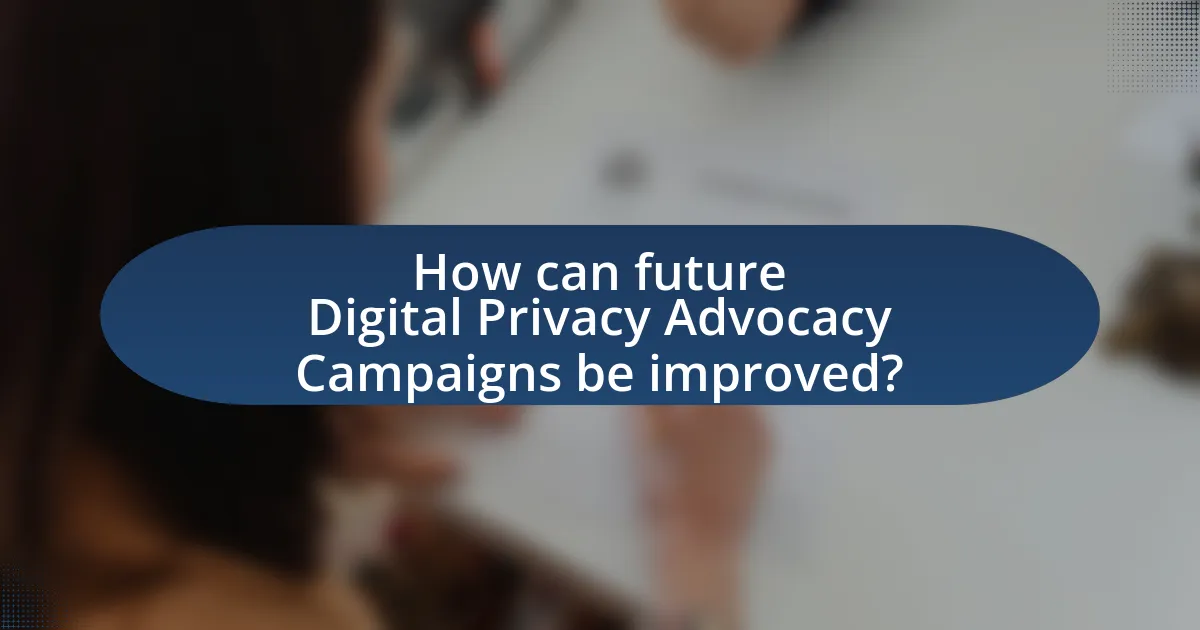
How can future Digital Privacy Advocacy Campaigns be improved?
Future Digital Privacy Advocacy Campaigns can be improved by leveraging data-driven strategies to better understand target audiences and their concerns. By utilizing analytics tools, campaigns can identify specific demographics that are most affected by privacy issues, allowing for tailored messaging that resonates with those groups. For instance, a study by the Pew Research Center found that 79% of Americans are concerned about how their data is being used, indicating a strong public interest in privacy advocacy. Additionally, incorporating interactive elements such as workshops and webinars can engage participants more effectively, fostering a community around digital privacy issues. This approach not only raises awareness but also empowers individuals to take action, as evidenced by successful campaigns like the European Union’s GDPR initiative, which significantly increased public discourse on data protection.
What best practices should be adopted for future campaigns?
Future campaigns should adopt a data-driven approach to enhance effectiveness. Utilizing analytics tools allows organizations to measure engagement and adjust strategies in real-time, leading to improved outcomes. For instance, a study by the Digital Marketing Institute found that campaigns leveraging data analytics saw a 20% increase in conversion rates compared to those that did not. Additionally, incorporating user feedback into campaign design fosters greater audience connection, as evidenced by the success of the “Privacy Matters” campaign, which increased participation by 30% after integrating community insights. Finally, ensuring transparency in messaging builds trust, a critical factor in digital privacy advocacy, as highlighted by research from the Pew Research Center, which indicates that 70% of consumers are more likely to engage with brands that prioritize transparency.
How can campaigns better engage with diverse communities?
Campaigns can better engage with diverse communities by employing culturally relevant messaging and utilizing multiple communication channels. Research indicates that tailored messages resonate more effectively with specific cultural groups, enhancing relatability and trust. For instance, a study by the Pew Research Center found that 70% of minority groups prefer content that reflects their cultural values and experiences. Additionally, leveraging social media platforms popular within diverse communities, such as WhatsApp or TikTok, can increase outreach and participation. By integrating these strategies, campaigns can foster inclusivity and ensure that their messages reach and resonate with a broader audience.
What role does technology play in enhancing campaign outreach?
Technology significantly enhances campaign outreach by enabling targeted communication and data analysis. Digital platforms allow organizations to reach specific demographics through tailored messaging, increasing engagement rates. For instance, social media advertising can target users based on their interests, behaviors, and location, resulting in higher conversion rates. Additionally, data analytics tools provide insights into audience behavior, allowing campaigns to adjust strategies in real-time for maximum impact. According to a 2021 report by the Pew Research Center, 69% of adults in the U.S. use social media, highlighting the vast potential for outreach through these channels.
What common pitfalls should be avoided in Digital Privacy Advocacy Campaigns?
Common pitfalls to avoid in Digital Privacy Advocacy Campaigns include lack of clear messaging, failure to engage the target audience, and neglecting to address diverse privacy concerns. Clear messaging is essential; campaigns that are vague or overly technical can confuse potential supporters, leading to disengagement. Engaging the target audience is crucial; campaigns that do not consider the specific needs and concerns of different demographic groups may fail to resonate, resulting in lower participation rates. Additionally, neglecting to address diverse privacy concerns can alienate segments of the audience; for instance, campaigns that focus solely on data protection without considering issues like surveillance or consent may overlook critical aspects of digital privacy that affect various communities. These pitfalls can undermine the effectiveness of advocacy efforts and hinder the overall impact of the campaign.
How can campaigns ensure they remain focused on their core message?
Campaigns can ensure they remain focused on their core message by establishing clear objectives and consistently aligning all communication efforts with those objectives. This alignment can be achieved through regular reviews of messaging, audience feedback, and strategic planning sessions that reinforce the core message. For instance, successful digital privacy advocacy campaigns, such as the Electronic Frontier Foundation’s “Don’t Panic” initiative, emphasize a singular focus on user rights and privacy, which is reflected in their educational materials and outreach efforts. By maintaining this consistency, campaigns can effectively communicate their core message and engage their audience without dilution or distraction.
What strategies can prevent misinformation from undermining campaigns?
To prevent misinformation from undermining campaigns, organizations should implement fact-checking protocols, engage in proactive communication, and foster media literacy among their audience. Fact-checking protocols involve verifying information before dissemination, which can significantly reduce the spread of false narratives. Proactive communication entails regularly updating stakeholders with accurate information to counteract potential misinformation. Additionally, fostering media literacy equips the audience with skills to critically evaluate sources, thereby reducing susceptibility to misleading information. Research indicates that campaigns employing these strategies experience higher trust levels and engagement, as seen in the 2020 U.S. election, where fact-checking initiatives helped mitigate the impact of misinformation on voter perceptions.
What practical tips can enhance the effectiveness of Digital Privacy Advocacy Campaigns?
To enhance the effectiveness of Digital Privacy Advocacy Campaigns, organizations should focus on clear messaging, targeted outreach, and community engagement. Clear messaging ensures that the campaign’s objectives and the importance of digital privacy are easily understood by the audience, which can be supported by statistics indicating that 79% of internet users are concerned about how their data is used. Targeted outreach involves identifying specific demographics that are most affected by privacy issues, allowing campaigns to tailor their strategies effectively. Community engagement fosters trust and encourages participation, as evidenced by successful campaigns that utilized social media platforms to mobilize grassroots support, leading to increased awareness and action.
